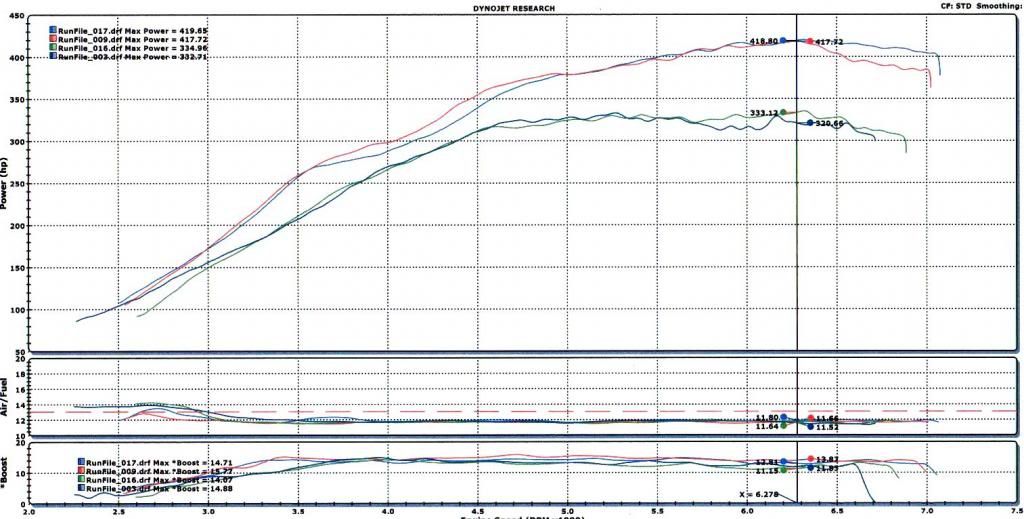| Message |
You will realize greater overall gains increasing flow in the rest of the air moving parts before upgrading turbos.
The stock turbo flows extremely well when the rest of the system can breathe, the gains from turbos with small piping is only a small area at higher RPM, you lose low end power and make the overall powerband less if you upgrade turbos without breather mods.Engines make power based on the volume of air they can move............ The 2 ways that allow more power in a turbo set up are, removing restrictions so that more air volume can move at the same pressure, and turning up the boost and forcing more air through the system.
If you remove restrictions from the system, you make a larger power band and can make more power with the same fuel octane.
If you force more air through a restricted system with more boost, you make more heat that requires higher octane fuel to resist detonation. The stock intercooler pipe is 2 inches, the stock exhaust pipes are 2 inches to 2.25 in different areas, both are crazy restrictive for stock turbos.
The next size up exhaust pipes (2.5") help a lot, but still are a major restriction for even stock turbos. A full 2.5" turbo back exhaust has 6 PSI backpressure in the downpipes at 15 PSI boost. This backpressure causes the turbo to spool more slowly and limits the possible power due to the heat created by the resistance. The exhaust is hottest and most expanded coming out of the turbo and requires the most room, this is why expansion pipes make such a dramatic difference that go to 3 inches. It creates a low pressure area for the exhaust gases to freely move to.
The turbo is driven by the difference in temperature and pressure on each side of the exhaust wheel. More heat before the turbo, less heat after the turbo. More pressure before the turbo, less pressure after the turbo.
The 3 inch expansion pipes have less than 1/2 a PSI backpressure at 25 PSI with sport 700 turbos, zero with stock turbos at full boost.
The 2.5" intercooler pipes also make a dramatic difference over the stock 2 inch intercooler pipes because they remove restriction/resistance from the system and allow the turbo to self feed faster and allow more air flow volume without needing more pressure. The Ash massive intercoolers also allow much more air to more by reducing resistance and offer a much better cooling with the large core. The air speed of the stock 2 inch intercooler pipe is way too fast with even stock turbos, this causes the air flow to go from laminar flow to turbulent flow. When the air speed is so high, it causes pressure drop, this occurs because the speed causes the air to form bubbles on the surface of the pipe from the heat (similar to boiling water) and makes the flow area even smaller. The stock pipes have a 2 pound pressure drop at 15 PSI boost with stock turbos. The 2.5" pipes only have .2 pressure drop at up to 25 PSI with sport 700 turbos.
With the small pipes the turbos requiring making more boost to get the same manifold pressure, that creates heat that drops power. Also by slowing the air speed through the pipes and intercoolers, the intercoolers have more time to cool the charge air. Larger turbos allow more air to flow through the engine because they remove restriction of the smaller wheels on both the intake and exhaust side, but if the rest of the parts are restricting the flow, it is going to take longer to force the air through to drive the turbos.
A good way to look at it is that you can only get so much water out of a garden hose.....You can turn up the pressure and you will get more out of it, but it is still limited by the size of the hose.
Take a fire hose and even at low pressure the volume is much greater than the garden hose running full blast. The turbos are not the smallest restriction in the system, in order to have a good power band with bigger turbos, the rest of the systems restrictions need to be removed.
On stock turbos, with full 2.5" turbo back exhaust, larger intercoolers, single pop, we use to get about 330 Rear wheel HP at 14 to 15 PSI on 91 octane pump fuel.....
Now with stock turbos, 3 inch exhaust, 2.5" intercooler pipes, 2.5" massive intercoolers, dual pops and MSP manifolds at the same 14 to 15 PSI boost, we get about 415 Rear wheel HP on 91 octane pump fuel. And over 500 at the tires on E85 I have included a dyno chart of 4 cars, all 4 cars have completely stock engines and stock turbos, all 4 cars have over 100K miles on the engines, all 4 cars are running 91 octane and all 4 cars are running similar mid 11 air fuel ratios. All cars have boost controllers and all are running in the 14 PSI to 15 PSI range.
2 of the cars have 2.5" full exhaust, larger intercoolers, single pop and larger injectors.
2 of the cars have 3" full exhaust, 2.5" intercooler pipes and Ash massives, selin dual pops, MSP manifolds, 740cc injectors. On the breather cars, notice how fast the boost comes up and how well it holds boost compared to the 2 more restricted cars.
Again, with larger turbos, the low end will be worse with the restricted parts and it will make more peak power for a small area, but increase in power will not be dramatic without running higher boost that requires higher octane. 
 |
 |

